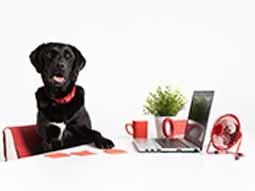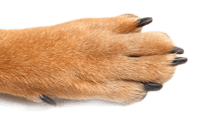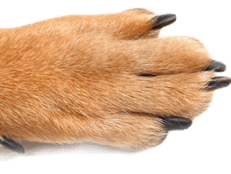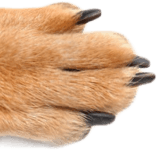
While dogs are generally great at fitting into our lives and families, there are certain dogs who can find the life we expect them to lead more difficult, and there are situations and triggers in our crazy lives that can worry our dogs, make them feel stressed, and can cause them anxiety.
Understanding how your dog feels and being able to recognise both the potential causes and the symptoms, can help you manage situations that cause your dog to feel anxious.
Are some dog breeds prone to anxiety?
There are some individuals, types, and/or breeds who are less confident, have less resilience, and who are generally more worried and anxious. New situations worry them far more, and the things that most dogs accept as being part of life, can be overwhelming for them. These dogs also don’t have good bounce-back skills – so scary things that most dogs can brush off fairly quickly can take more of a lasting toll on them.
This can be as a result of genetics, breeding, upbringing, lack of habituation and socialisation, or past history but these are dogs who need more support and understanding in their day-to-day life.
Working with a behaviourist to recognise the individual causes and triggers, and to help them build confidence can transform life for these dogs.
Situations that can cause anxiety in dogs
Anxiety in dogs is most usually situational, so in most cases, you don’t have an ‘anxious dog’, you have a dog that feels anxious in certain situations. Being able to identify and predict those situations, means you can prevent a lot of your dog’s anxious behaviour, and manage these episodes far better. Also, once you have identified these situations, you can work with your dog to help them feel happier and more confident in those situations – although you may need help from a behaviourist to do this.
It is important to understand canine anxiety, as it has a significant impact on your dog’s quality of life, and what starts off as anxiety in certain situations can generalise to wider anxiety at other times, and this can then develop into other behaviour problems. Here's a variety of situations that could cause your dog to feel anxious.
Moving into a new home
Bringing a dog or puppy into a new home can be overwhelming for them, much like it is for humans. This sudden change in environment could trigger anxiety as they leave behind everything that’s familiar to them - including all the usual sights, sounds and scents, and their usual predictable routine. It is important to try and create a sense of familiarity in the new environment and stick to your dog’s regular routine. Familiar scents, bedding, toys etc, and a sense of predictability in amongst all the novelty, can help prevent anxiety.
Developmental fear periods
While we often understand that very young puppies might lack confidence, there are also other times during a dog’s development from a puppy to an adult when they can react fearfully or with anxiety to novelty or to things that they have previously taken in their stride. These are periods when a puppy begins to look at the world with more independent eyes and often is reassessing whether things are safe or dangerous now that they are going to have to deal with them as an adult dog and not with their mum or caregiver to give them back up. It’s important that owners recognise this and let their dog regain their confidence in their own time.
It’s also important that owners don’t put their dog into situations that are overwhelming or scary for them at this age – as things that are experienced during these fear phases can shape their behaviour and reactions in the future.
The first of these periods is between 8-11 weeks of age, and the second is between 6-14 months of age. In some dogs this lasts a few weeks and in others a few months. The signs are different for each dog. They might be more hesitant, they might be fearful in situations they’ve been happy in before, they may react differently to other dogs, they might be more hyperactive – or they may be clingier and more anxious. It is important to recognise these periods as being natural, and being patient and letting your dog reassess things in their own time.
Changes in environment or social group
Moving house, building work, new family members (human or non-human), bereavements, external noises etc can all disrupt a dog’s sense of security and make them feel more anxious. Trying to keep a routine for your dog no matter what else is going on, keeping their immediate environment as unchanged as possible, and being aware that they need your support, help them through these life blips.
Inappropriate training methods
Shouting, smacking or losing your temper with your dog in training, or using aversive equipment or methodology, can cause pain, fear, loss of confidence, and anxiety. It also leads to lack of trust in their owner. This can impact all areas of your dog’s life. Use reward-based training methods, and if you are not sure how, find a good training class that can help you.
Lack of consistency
Just like children, dogs need to feel a secure attachment with their guardians. This consistency, predictability and trust is key to building a strong bond, and to their feelings of safety and security. When a caregiver (or different people within the family group) are unpredictable, inconsistent, or random in terms of their actions or reactions, dogs can easily become anxious.
Lack of enrichment
All dogs need an outlet for their own individual hardwired behaviours and the mental stimulation and internal reward this brings. Without this, dogs can develop all kinds of behaviour problems as a result of becoming frustrated, depressed or anxious.
Fears and phobias
There are many things in a dog’s life that can give rise to fears or phobias. The most common are noise (firework night, thunderstorms etc), being left alone, and, in unsocialised or badly socialised dogs, unknown dogs and/or people.
All of these, if untreated, can cause more generalised anxiety that spreads out into day-to-day life as the dog worries about ‘when is it going to happen next?’ and so can’t ever really settle or relax.
If your dog is scared or fearful in any of these situations, understanding and addressing their fears is crucial for their wellbeing.
How can you recognise anxiety in dogs?
You will be able to recognise when your dog is feeling anxious by looking at their body language. These symptoms of anxiety include:
- Lip licking
- Yawning
- Pacing
- Inability to settle
- Panting
- Trembling
- Salivation
- Hiding or attempts to escape
- Destructive behaviour (often at doors)
- Vocalisation (whining or barking)
- Lowered body posture
- Tail tucking
- Refusal to take treats/food
- Self-mutilation (chewing or licking paws)
- Aggression
Every dog is different however and each individual will show different signs when they are feeling worried or anxious, so it is important to know your own dog.
If any of these behaviours are new or have started suddenly, visit your vet to check for a clinical cause.
Helping an anxious dog
Many of the causes of anxiety are transitory - new homes and new environments become familiar with patience and time, fear periods pass, and owners recognise the things that their dog worries about and removes them or avoids them.
If a dog is more generally anxious and worried, help from a behaviourist is the best way to ensure you can help your dog and grow their confidence. This might be controlled exposure to the source of their worry but at a safe distance beyond the point where they react, and with plenty of treats to start to change the associations from the object of their worry. Or it might be generally building their confidence in other areas of their life. A professional can help put together the perfect behaviour modification plan for your dog to make their anxiety a thing of the past.
Until you can get professional help, it is important to try and avoid situations or triggers that your dog finds difficult to deal with.
How do I know if my puppy is ‘anxious’?
When you bring your puppy home for the first time, it's understandable to be concerned about their well-being. Everything is brand new for them and they are experiencing being alone for the very first time in their young life. This significant change, being away from their mother and littermates and introduced to unfamiliar people, sights, sounds, and smells, can naturally lead to behaviours that might look like anxiety.
It's important to recognise that some initial hesitation, wariness, or even tentative behaviours are a normal part of settling in. A puppy lacking confidence or appearing worried in these early stages is often just adjusting to their new environment, not necessarily displaying true anxiety. They are simply taking time to find their paws and understand their surroundings.
Your role is to provide a calm and supportive environment, allowing them the space and time they need to explore their new life and family at their own pace. By being patient and gentle, you'll help them gradually build confidence and feel completely at home.
While some puppies settle in quickly, within hours, others can take days or even a few weeks to fully adjust and show their true personalities. Observing their behaviour over time will help you distinguish between normal adjustment and potential signs of genuine anxiety that might require further attention.
Knowing what the signs are in a dog experiencing anxiety is so important. Canine anxiety can stem from a variety of factors, from genetic predispositions and early experiences as a puppy to situational triggers and inappropriate training methods. Understanding the root causes and recognising the subtle signs of anxiety is the first step towards helping a dog manage anxiety.





